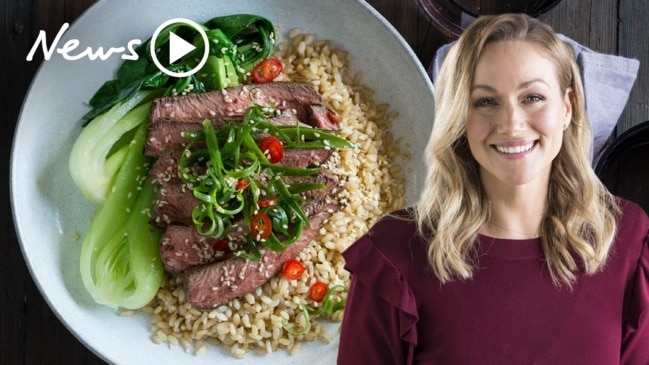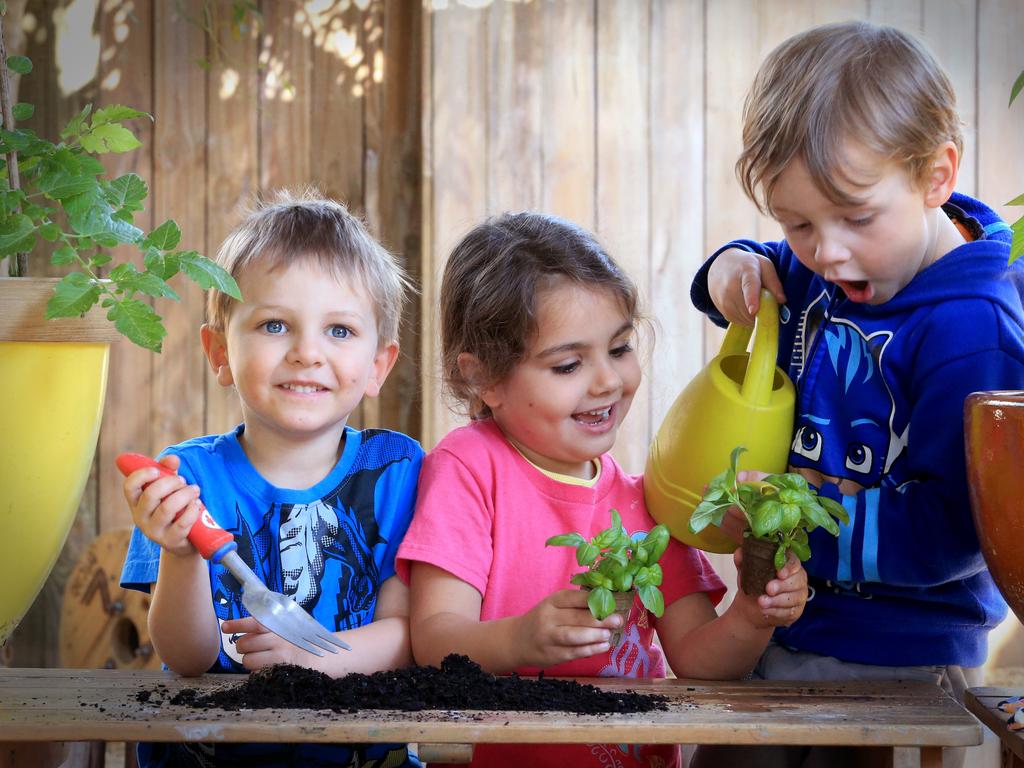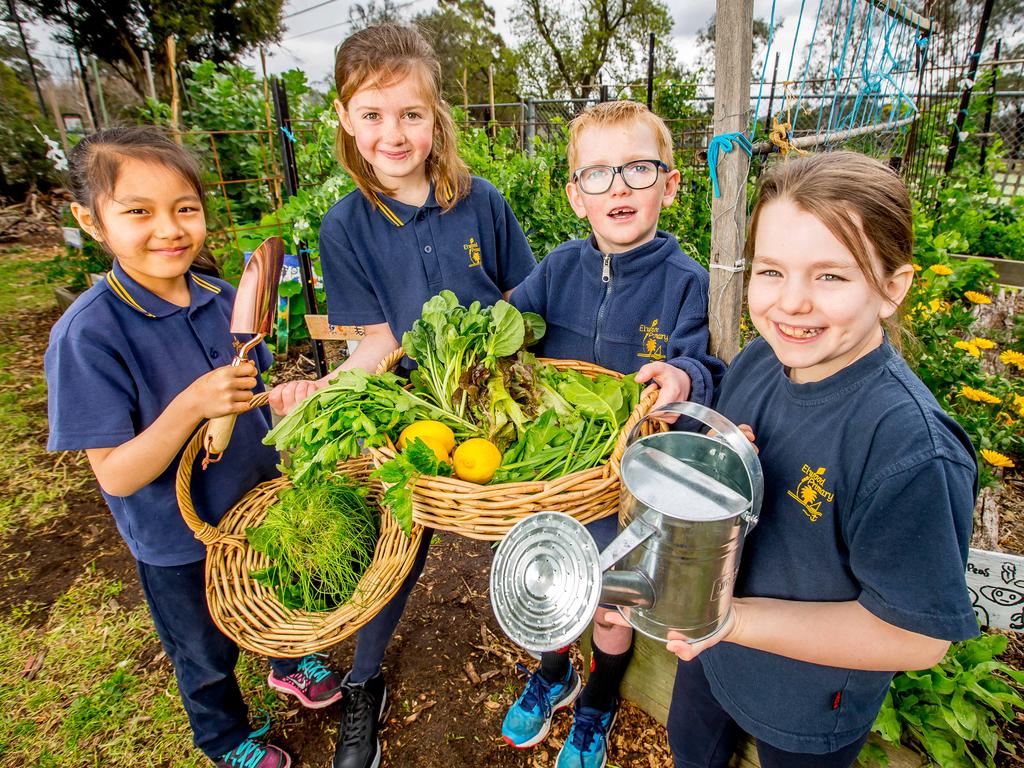Kids don’t know where fruit and vegetables come from
AUSTRALIAN parents are not teaching their kids about where fruit and vegetables come from — many think they come from the supermarket or “the fridge”.

AUSTRALIAN parents are failing to teach their kids about where fruit and vegetables come from with a quarter of youngsters thinking they originate from the supermarket and 6 per cent thinking they come from “the fridge”.
Only 10 per cent can correctly identify they are grown from seeds.
News Corp Australia commissioned research on the topic as our children’s connection with food slumps and their waistlines increase.
More than a third of children aged 3-5 think fruit and vegetables come from the supermarket and not farmers or seeds and 8 per cent of children in that category think fruit and vegetables come from “the fridge”.
The same number correctly think they come from seeds.
Of children aged 6-8-years-old, 22 per cent can only identify 5-6 vegetables in their raw state, 12 per cent can only identify 1-2 vegetables in their raw state.
Even 12 per cent of children aged 12-14 think fruit and vegetables originate from the supermarket.

A total of 70 per cent of parents would like their children to know more about fruit and vegetables and where they come from with 88 per cent responding having a home vegetable garden and planting seeds would help to increase their children’s awareness.
The survey, conducted by the NewsConnect panel was of 1012 parents with children aged 3-14.
It shows just how disconnected children are from their food and how it is grown as 1 in 4 Australian children are considered to be overweight or obese.
Miriam Raleigh, nutritionist with Child Nutrition, said she was “floored” by the figures.
“I am shocked, the awareness is much, much lower than even I would have expected — particularly in that 12-year-old group. It is terrifying.”
“These kids know how to upload a video but they don’t know where fruit and vegetables come from — that is quite scary.”
Ms Raleigh said food education needed to become a core part of the school curriculum.
“Parents and teachers need to take this more seriously because our children’s health is at risk,” she said.

AMA President Tony Bartone said the research highlighted the need for increased health and nutrition literacy for our children.
“When there is that kind of level of misinformation (about where fruit and vegetables come from) at such an early age we really need to address it from an education perspective,” Dr Bartone said.
“For the first time in a century, given the level and burden of disease and morbidity, we are looking at the prospect of a future generation of children with a life expectancy reduced in comparison to that of their parents.”
Australia is one of the fattest nations in the world.
One in four Australian children is considered to be overweight or obese with Australia the fifth most obese nation according to the OECD.

Alice Zaslavsky, former MasterChef alum and creator of new food education resource for kids Phenomenon, said the research was “enough to make you weep” and the push for higher NAPLAN scores had resulted in a generation of kids not educated about healthy food choices.
“Food literacy has been pushed off the table in the race for great NAPLAN results and kids learning their times table,” Ms Zaslavsky said.
Josephine Duffy, CEO of the Stephanie Alexander Kitchen Garden program said the organisation was definitely seeing many children engaging in the program who have “no idea that vegetables come from the ground”.
“It’s extremely concerning and we do need more resources and funding to fix this problem.”
BREAKDOWN OF STATS
OVERALL RESULTS
Thinking about your youngest child, where do they think fruits and vegetables come from?
Supermarket: 25.04 per cent
The garden: 29.36 per cent
Seeds: 10.67 per cent
Farmers: 28.70 per cent
The fridge: 5.39 per cent
Other: 0.84 per cent
How many different vegetables can your youngest child identify in their raw state?
None: 0.59%
1-2: 8.60 per cent
3-4: 17.19 per cent
5-6: 22.33 per cent
7-9: 14.53 per cent
10 or more: 36.76 per cent

How many different types of fruit can your youngest child identify in their raw state?
None: 0.69 per cent
1-2: 6.03 per cent
3-4: 15.02 per cent
5-6: 26.19 per cent
7-9: 17 per cent
10 or more: 35.08 per cent
Do you wish your children knew more about where fruit and vegetables came from?
Yes: 69.57 per cent
No: 30.43 per cent
Do you think having a home garden and planting seeds with your children would help improve their knowledge of where food comes from?
Yes: 88.74 per cent
No: 11.26 per cent

AGE BREAKDOWNS
3-5 YEAR OLDS
Thinking about your youngest child, where do they think fruits and vegetables come from?
Supermarket: 34.97 per cent
The garden: 27.30 per cent
Seeds: 8.13 per cent
Farmers: 20.71 per cent
The fridge: 7.52 per cent
Other: 1.38 per cent
How many different vegetables can your youngest child identify in their raw state?
None: 1 per cent
1-2: 11.69 per cent
3-4: 22.89 per cent
5-6: 29.35 per cent
7-9: 10.70 per cent
10 or more: 24.38 per cent
6-8 YEAR OLDS
Thinking about your youngest child, where do they think fruits and vegetables come from?
Supermarket: 22.09 per cent
The garden: 34.92 per cent
Seeds: 11.40 per cent
Farmers: 27.79 per cent
The fridge: 3.80 per cent
Other: 0 per cent

How many different vegetables can your youngest child identify in their raw state?
None: 0.39 per cent
1-2: 12.11 per cent
3-4: 20.31 per cent
5-6: 22.66 per cent
7-9: 12.50 per cent
10 or more: 32.03 per cent
9-12 YEAR OLDS
Thinking about your youngest child, where do they think fruits and vegetables come from?
Supermarket: 19.82 per cent
The garden: 27.13 per cent
Seeds: 13.41 per cent
Farmers: 33.84 per cent
The fridge: 4.88 per cent
Other: 0.91 per cent
12-14 YEAR OLDS
Thinking about your youngest child, where do they think fruits and vegetables come from?
Supermarket: 11.94 per cent
The garden: 28.36 per cent
Seeds: 12.31 per cent
Farmers: 43.28 per cent
The fridge: 3.36 per cent
Other: 0.75 per cent


